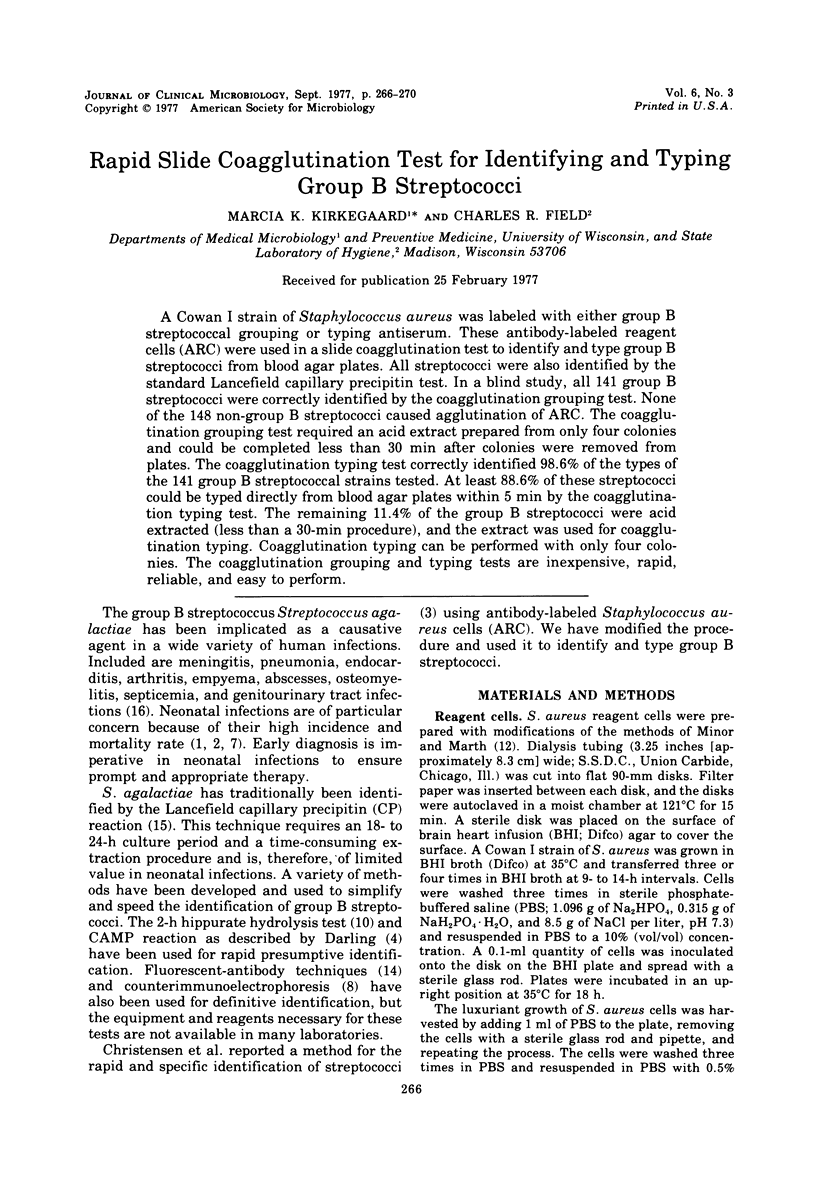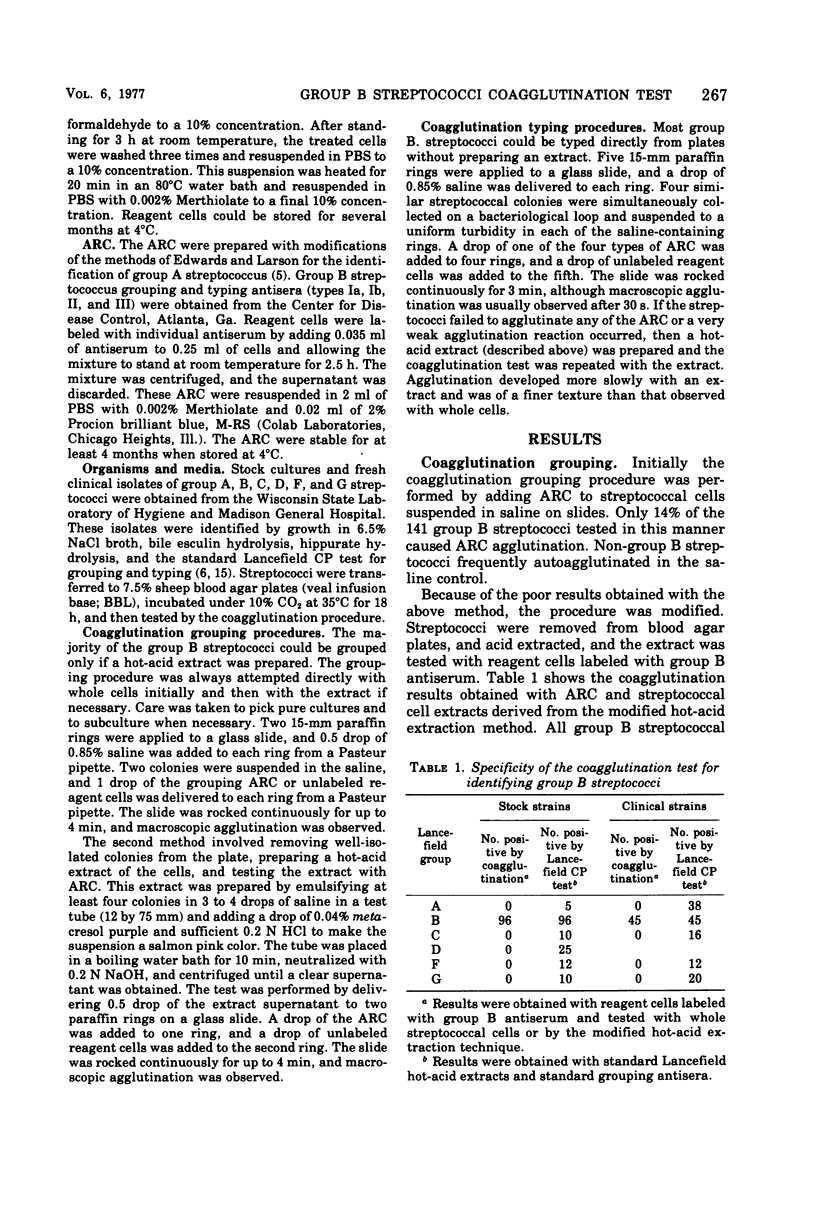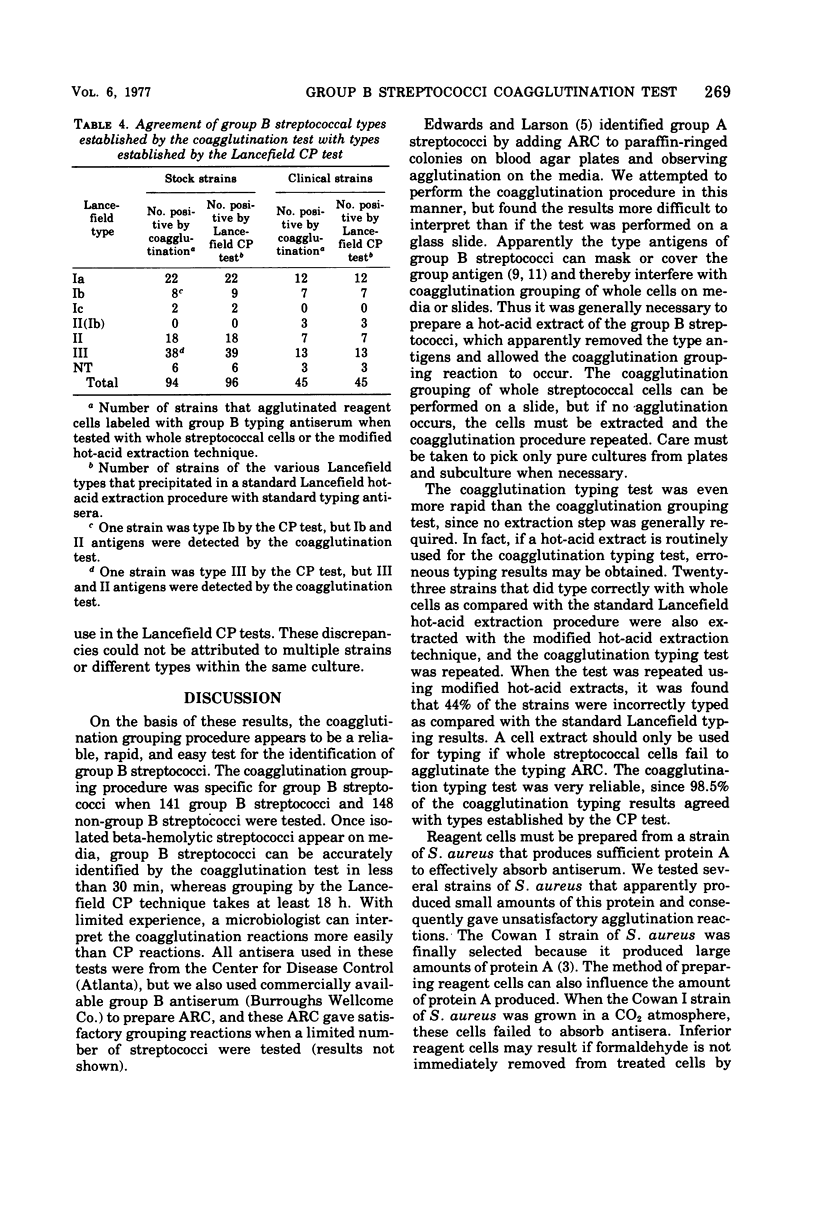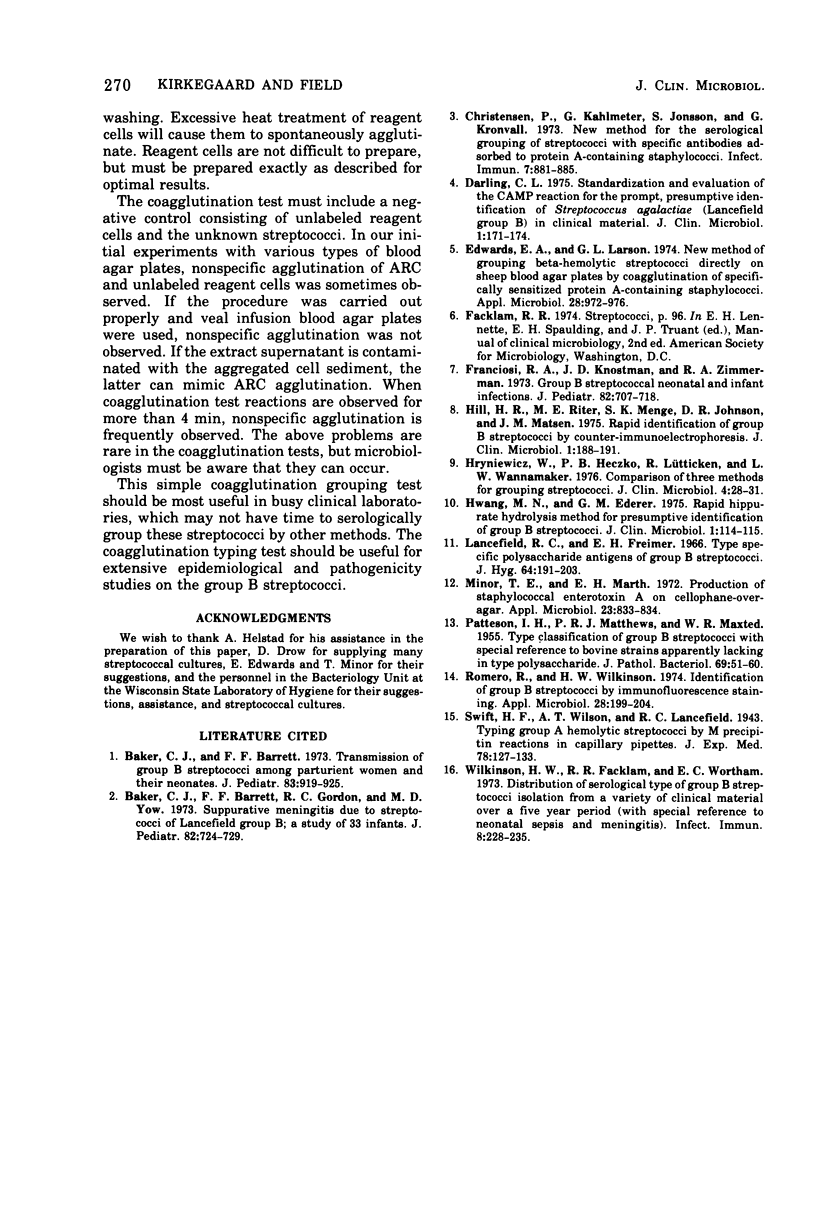Abstract
A Cowan I strain of Staphylococcus aureus was labeled with either group B streptococcal grouping or typing antiserum. These antibody-labeled reagent cells (ARC) were used in a slide coagglutination test to identify and type group B streptococci from blood agar plates. All streptococci were also identified by the standard Lancefield capillary precipitin test. In a blind study, all 141 group B streptococci were correctly identified by the coagglutination grouping test. None of the 148 non-group B streptococci caused agglutination of ARC. The coagglutination grouping test required an acid extract prepared from only four colonies and could be completed less than 30 min after colonies were removed from plates. The coagglutination typing test correctly identified 98.6% of the types of the 141 group B streptococcal strains tested. At least 88.6% of these streptococci could be typed directly from blood agar plates within 5 min by the coagglutination typing test. The remaining 11.4% of the group B streptococci were acid extracted (less than a 30-min procedure), and the extract was used for coagglutination typing. Coagglutination typing can be performed with only four colonies. The coagglutination grouping and typing tests are inexpensive, rapid, reliable, and easy to perform.
Full text
PDF




Selected References
These references are in PubMed. This may not be the complete list of references from this article.
- Baker C. J., Barrett F. F., Gordon R. C., Yow M. D. Suppurative meningitis due to streptococci of Lancefield group B: a study of 33 infants. J Pediatr. 1973 Apr;82(4):724–729. doi: 10.1016/s0022-3476(73)80606-7. [DOI] [PubMed] [Google Scholar]
- Baker C. J., Barrett F. F. Transmission of group B streptococci among parturient women and their neonates. J Pediatr. 1973 Dec;83(6):919–925. doi: 10.1016/s0022-3476(73)80524-4. [DOI] [PubMed] [Google Scholar]
- Christensen P., Kahlmeter G., Jonsson S., Kronvall G. New method for the serological grouping of Streptococci with specific antibodies adsorbed to protein A-containing staphylococci. Infect Immun. 1973 Jun;7(6):881–885. doi: 10.1128/iai.7.6.881-885.1973. [DOI] [PMC free article] [PubMed] [Google Scholar]
- Darling C. L. Standardization and evaluation of the CAMP reaction for the prompt, presumptive identification of Streptococcus agalactiae (Lancefield group B) in clinical material. J Clin Microbiol. 1975 Feb;1(2):171–174. doi: 10.1128/jcm.1.2.171-174.1975. [DOI] [PMC free article] [PubMed] [Google Scholar]
- Edwards E. A., Larson G. L. New method of grouping beta-hemolytic streptococci directly on sheep blood agar plates by coagglutination of specifically sensitized protein A-containing staphylococci. Appl Microbiol. 1974 Dec;28(6):972–976. doi: 10.1128/am.28.6.972-976.1974. [DOI] [PMC free article] [PubMed] [Google Scholar]
- Franciosi R. A., Knostman J. D., Zimmerman R. A. Group B streptococcal neonatal and infant infections. J Pediatr. 1973 Apr;82(4):707–718. doi: 10.1016/s0022-3476(73)80604-3. [DOI] [PubMed] [Google Scholar]
- Hill H. R., Riter M. E., Menge S. K., Johnson D. R., Matsen J. M. Rapid identification of group B streptococci by counterimmunoelectrophoresis. J Clin Microbiol. 1975 Feb;1(2):188–191. doi: 10.1128/jcm.1.2.188-191.1975. [DOI] [PMC free article] [PubMed] [Google Scholar]
- Hryniewicz W., Heczko P. B., Lütticken R., Wannamaker L. W. Comparison of three methods for grouping streptococci. J Clin Microbiol. 1976 Jul;4(1):28–31. doi: 10.1128/jcm.4.1.28-31.1976. [DOI] [PMC free article] [PubMed] [Google Scholar]
- Hwang M. N., Ederer G. M. Rapid hippurate hydrolysis method for presumptive identification of group B streptococci. J Clin Microbiol. 1975 Jan;1(1):114–115. doi: 10.1128/jcm.1.1.114-115.1975. [DOI] [PMC free article] [PubMed] [Google Scholar]
- Lancefield R. C., Freimer E. H. Type-specific polysaccharide antigens of group B streptococci. J Hyg (Lond) 1966 Jun;64(2):191–203. doi: 10.1017/s0022172400040456. [DOI] [PMC free article] [PubMed] [Google Scholar]
- Minor T. E., Marth E. H. Production of staphylococcal enterotoxin A on cellophage-over-agar. Appl Microbiol. 1972 Apr;23(4):833–834. doi: 10.1128/am.23.4.833-834.1972. [DOI] [PMC free article] [PubMed] [Google Scholar]
- PATTISON I. H., MATTHEWS P. R., HOWELL D. G. The type classification of group-B streptococci, with special reference to bovine strains apparently lacking in type polysaccharide. J Pathol Bacteriol. 1955 Jan-Apr;69(1-2):51–60. [PubMed] [Google Scholar]
- Romero R., Wilkinson H. W. Identification of group B streptococci by immunofluorescence staining. Appl Microbiol. 1974 Aug;28(2):199–204. doi: 10.1128/am.28.2.199-204.1974. [DOI] [PMC free article] [PubMed] [Google Scholar]
- Wilkinson H. W., Facklam R. R., Wortham E. C. Distribution by serological type of group B streptococci isolated from a variety of clinical material over a five-year period (with special reference to neonatal sepsis and meningitis). Infect Immun. 1973 Aug;8(2):228–235. doi: 10.1128/iai.8.2.228-235.1973. [DOI] [PMC free article] [PubMed] [Google Scholar]


